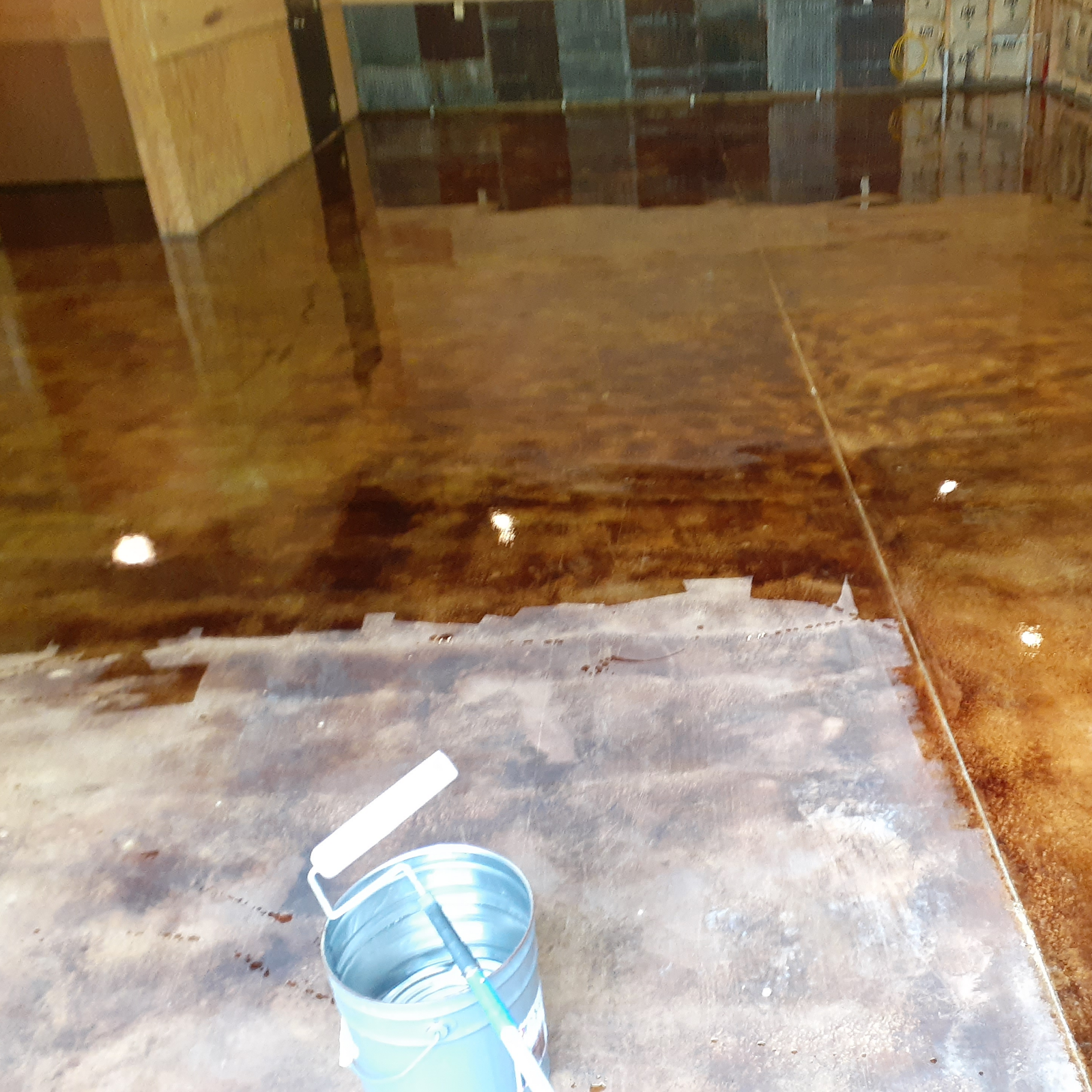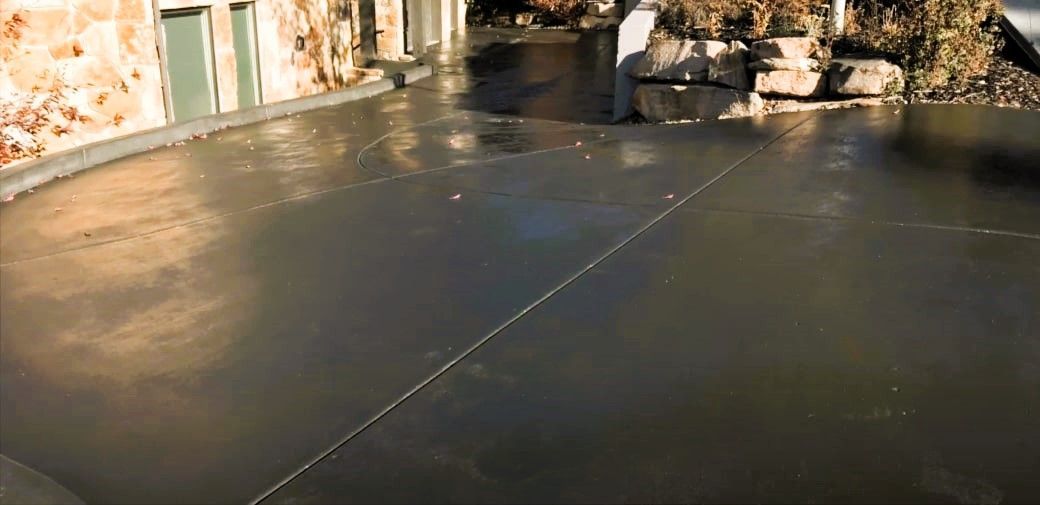The ultimate guide to stained concrete and its applications
Comprehending the Various Types of Stained Concrete for Your Following Job
Stained concrete offers different choices that satisfy various aesthetic and functional needs. Each type presents unique qualities that influence the final look and toughness of the surface. Recognizing these differences is vital for any person preparing a project. From rich, chain reactions of acid-based stains to the vibrant harmony of solid shade stains, the options can greatly impact the end result. What aspects should one think about when selecting the excellent discolor for their particular requirements?
Overview of Stained Concrete
Stained concrete functions as a functional flooring alternative that can enhance the aesthetic charm of different areas. This strategy includes applying a coloring representative to the surface of existing concrete, permitting for a broad spectrum of layout possibilities. Stained concrete is preferred in both property and commercial atmospheres, offering a durable and low-maintenance remedy that can mimic the appearance of all-natural materials like stone or floor tile.
The discoloration process can be carried out using water-based or solvent-based items, each offering distinctive visual effects. The last appearance is affected by elements such as the initial concrete surface area, the sort of tarnish made use of, and the application approach. Stained concrete not just improves insides and outsides however likewise promotes sustainability by rejuvenating existing concrete frameworks. Therefore, it has obtained traction amongst property owners and designers seeking both performance and design in their floor covering choices.
Acid-Based Stains: Characteristics and Benefits

One-of-a-kind Shade Variants
Concrete surface areas can change substantially with the application of acid-based stains, which provide an abundant scheme of distinct shade variations. These stains permeate the concrete, responding chemically to generate dynamic planet tones that vary from deep browns and reds to soft eco-friendlies and blues. The resulting tones are commonly variegated, developing a natural, marble-like appearance that improves the concrete's personality. Each application returns unique results as a result of variations in the concrete's structure and the discoloration strategy used, making every job distinct. In addition, acid-based stains can be split or combined with various other strategies to create personalized designs, enabling for personal expression. This flexibility makes acid-based stains a prominent option for both household and business applications.
Chain Reaction Discussed
While lots of aspects add to the effectiveness of acid-based stains, the underlying chemical reactions play an important duty in their distinct characteristics and benefits. These stains mainly contain water, acid, and metallic salts. When related to concrete, the acid reacts with the calcium hydroxide in the concrete, creating a chemical change that causes long-term shade modifications. The metallic salts penetrate the surface and bond with the concrete, enabling a vast array of shades and tones. This response not only boosts visual appeal yet likewise supplies toughness, making the color immune to fading and wear. Furthermore, acid-based stains can create a variegated coating that mimics natural stone, additional improving their appeal for ornamental concrete applications.
Surface Area Prep Work Relevance
Accomplishing excellent results with acid-based stains depends upon thorough surface area preparation. This vital step assurances that the concrete surface area is clean, free of impurities, and appropriately profiled for perfect tarnish absorption. Any type of existing sealers, dust, or oils can prevent the chemical reaction that creates the wanted color and coating, causing uneven or patchy outcomes.
Before using the stain, the concrete should be mechanically cleaned up or stress washed, complied with by a detailed assessment for fractures or blemishes that might need fixing. Additionally, validating the surface is effectively dried out will boost stain adherence. By prioritizing these preparatory actions, the long life and vibrancy of acid-based stains can be significantly enhanced, resulting in an extra aesthetically pleasing and resilient finish.
Water-Based Stains: Functions and Benefits

Water-based stains penetrate the concrete, using a more clear finish that highlights the natural structure and variants of the surface underneath. They are readily available in a broad explanation variety of shades, enabling imaginative flexibility in style. Additionally, water-based stains are much easier to cleanse up, needing just water and soap, which streamlines the application process.
Their quick drying out time enhances effectiveness, making them a sensible option for both do it yourself enthusiasts and specialists. In general, water-based stains give an appealing combination of visual versatility and easy to use residential properties, making them a popular alternative for concrete improvement tasks.
Strong Shade Stains: Dynamic Choices for a Vibrant Appearance
Solid color stains use a reliable remedy for those looking for to develop a vibrant and vibrant visual on concrete surface areas. These stains give a consistent coloration that can substantially boost the aesthetic appeal of floors, outdoor patios, and driveways. Available in a wide spectrum of hues, strong color stains permit innovative expression, accommodating various layout choices.
One of the vital benefits of strong shade stains is their capability to conceal imperfections, providing a fresh and sleek aim to aging concrete - stained concrete company. Furthermore, their formulation typically includes UV-resistant properties, ensuring long life and color retention also in extreme weather
Application is straightforward, needing minimal preparation of the concrete surface area. Once used, solid color stains can be sealed for included protection and luster, additional elevating their visual high quality. With their dynamic choices, strong color stains are an excellent selection for those going for an impactful and cohesive layout.
Semi-Transparent Stains: Accomplishing Deepness and Dimension
Semi-transparent stains supply a distinct method to boosting concrete surfaces by providing depth and measurement via different shade choices. Understanding the application strategies is crucial for accomplishing the wanted result, while appropriate maintenance methods assure durability. This area will discover these essential elements to maximize the advantages of semi-transparent staining.
Color Options Available
A wide array of color options exists for semi-transparent stains, enabling property owners and developers to boost the natural appeal of concrete surfaces. These stains are available in a range of tones, from natural tones like browns and terracottas to vibrant shades such as blues and greens. The semi-transparent nature of these stains enables the underlying concrete to reveal via, creating a distinct depth and click here for more info dimension that can enhance numerous design visual appeals. Additionally, combining various colors can generate customized tones, enabling a tailored look for each task. This adaptability makes semi-transparent stains a preferred choice for both exterior and interior applications, as they can harmonize with surrounding elements while adding aesthetic interest to plain concrete.
Application Techniques Discussed
To accomplish the preferred depth and dimension with semi-transparent stains, correct application strategies are important. First, surface preparation is crucial; the concrete should be clean and free of any type of pollutants. This frequently involves power washing and fixing any kind of cracks. Next off, selecting the ideal applicator, such as a sprayer, roller, or brush, can influence the final appearance. Sprayers enable for a much more even application, while rollers can help attain appearance. It is vital to use the stain in slim, also coats, allowing each layer to dry prior to adding another. Adjusting the application method, such as varying stress or making use of different tools, can develop unique effects. Securing the stained surface boosts the vibrancy of the colors while supplying protection.
Upkeep Ideal Practices
Routine upkeep is vital for maintaining the charm and honesty of surface areas treated with semi-transparent stains. To keep these surfaces, routine cleaning is important. Making use of a pH-neutral cleaner and a soft-bristle mop will certainly assist get rid of dirt and particles without harming the stain. It is advisable to prevent rough chemicals, as they can deteriorate the tarnish's appearance. Furthermore, routine resealing each to three years can secure versus wear and fading. This process includes cleaning up the surface extensively and using a suitable sealer developed for stained concrete. Property owners must additionally monitor for any signs of discoloration or damage and address these problems promptly to ensure resilient vibrancy and durability. Complying with these finest methods will improve the general lifespan of semi-transparent stained surface areas.
Results and Methods: Personalizing Your Stained Concrete
Personalizing stained concrete entails an array of methods that improve both appearances and performance. Amongst these techniques, layering various discolor colors can create depth and complexity, permitting for special aesthetic effects. Techniques such as acid staining provide a variegated appearance, while water-based stains use an extra uniform look.
Additionally, including ornamental patterns, such as stenciling or inscription, can further customize the surface, adding intricate designs that cater to individual tastes. Texturing the concrete, whether through stamping or broom coatings, presents responsive aspects that not only enhance grip but also enhance visual passion.
Moreover, applying sealants can intensify the shade vibrancy and offer security against wear. Personalization techniques extend past simple shade; they can change a conventional concrete slab right into a spectacular prime focus, making it ideal for both domestic and business areas. Through mindful selection of results and techniques, stained concrete can accomplish a really customized appearance.
Maintenance and Durability of Stained Surfaces
Although stained concrete surfaces are understood for their resilience and visual appeal, keeping their integrity is important for guaranteeing long life. Normal cleaning is essential; sweeping and mopping with a pH-neutral cleaner assists protect against dirt accumulation and discoloration. Additionally, applying a sealant every couple of years can protect the surface from moisture, chemicals, and UV damages, therefore enhancing its life expectancy.
It is likewise More hints vital to deal with any type of splits or chips immediately. Tiny repair work can mitigate further wear and tear, protecting the visual and structural high quality of the surface area. For exterior stained concrete, seasonal upkeep, such as eliminating snow and ice, is needed to stop surface damage from freeze-thaw cycles.
Regularly Asked Inquiries
Can I Discolor Existing Concrete Surfaces or New Ones?
The question of whether existing concrete surfaces can be stained emerges often. It is certainly possible to stain both brand-new and old concrete, provided the surface area is appropriately ready and without pollutants for optimal adhesion.
Just how Lengthy Does the Discoloration Process Normally Take?
The staining procedure normally takes one to three days, depending upon factors such as surface area preparation, sort of discolor, and climate condition. stained concrete company. Curing time may extend past preliminary application, affecting the general period considerably
Is Stained Concrete Safe for Outdoor Usage?
Stained concrete is generally secure for outside usage, provided it is effectively secured. This securing safeguards versus moisture and UV damage, ensuring longevity and security, while additionally enhancing the aesthetic appeal of outside rooms.
Can I Apply Several Discoloration Layers for Different Impacts?
Using multiple discolor layers can achieve diverse effects on stained concrete. It is essential to assure compatibility in between stains and allow appropriate drying out time in between applications to prevent unexpected responses or discoloration.
Are There Any Type Of Color Limitations for Stained Concrete?
Shade restrictions for stained concrete mainly rely on the kind of stain used, with water-based stains offering a wider combination contrasted to acid-based stains. stained concrete. Accomplishing lively shades may need careful choice and application strategies.